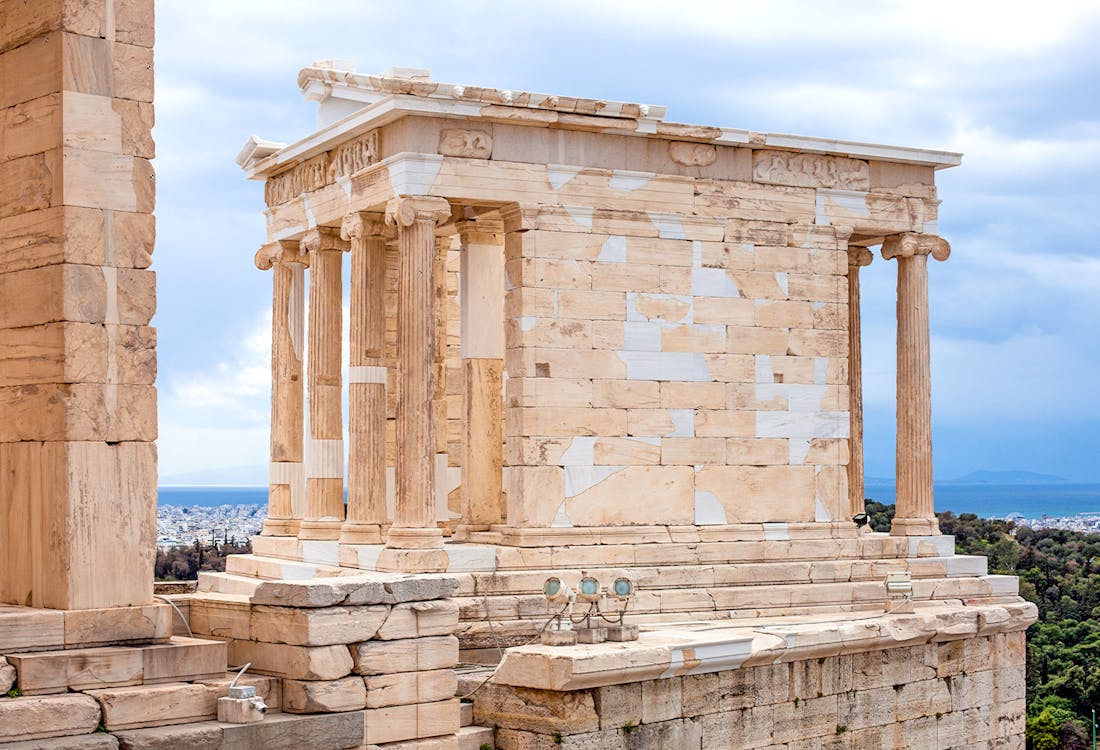As you approach the Acropolis of Athens, you'll spot an incredible little architectural gem that visitors somehow often overlook—the Temple of Athena Nike. Perched gracefully on the southwest bastion, this compact Ionic temple is steeped in stories of victory, protection, and Athenian artistic brilliance. Spend a bit of time exploring its friezes and you'll step right into Athens' golden age—a period buzzing with architectural innovation and military triumph.
A quick trip through history

Standing at the Temple of Athena Nike today puts you atop layers of fascinating history. Built around 420 BC—the heart of Athens' golden age—this architectural marvel actually sits above the remnants of an ancient Mycenaean bastion. The temple, designed by the Kallikrates (yes, the very same guy behind the Parthenon), replaced an earlier shrine that the Persians destroyed in 480 BC. Here's the cool fact: it's the first fully Ionic temple on the Acropolis, with unusual proportions making it pleasantly distinct from its contemporaries.
A symbol of eternal victory
Something special about this temple you won't find anywhere else: The statue of Nike (Victory) housed here was intentionally wingless. Athenians believed a wingless Nike meant victory would stick around forever. Pretty optimistic, right? While the actual statue hasn't survived the centuries, the symbolism perfectly captures ancient Athens' confident spirit and lofty ambitions.
A story of destruction and revival
The temple has had quite a turbulent journey. In 1687 Ottoman forces dismantled it (ouch!) to use its materials for fortifications. It lay ruined until Greece regained independence. Thanks to committed restoration efforts starting in the 1830s—led notably by archaeologist Ludwig Ross—it’s back in glorious form today. And the latest restoration wrapped up in 2010, ensuring you're seeing it at its very best.
What makes this temple special?
When you visit the Temple of Athena Nike, you'll discover a treasure trove of ancient artistry and symbolism. While the Parthenon might steal most visitors' attention, this smaller temple offers a more intimate connection to ancient Athens. Here's what makes it truly extraordinary:
Artistic masterpieces you can't miss
Sure, everyone flocks to the Parthenon—and don't get me wrong, that's justified—but skipping the Temple of Athena Nike means missing out on something uniquely intimate and beautifully preserved. Here's why it's worth a closer look:
Can't-miss artistic masterpieces
- The eastern frieze depicts an assembly of Greek gods like Athena, Zeus, and Poseidon.
- The southern scenes commemorate the Greek victory at Plataea—major historical bragging points.
- Definitely look out for "Nike Adjusting Her Sandal," known as one of the most graceful classical Greek sculptures.
- The northern frieze brings ancient cavalry battles vividly back to life.
Recommended tickets to the Acropolis
Architectural innovation

This little temple boldly pioneered a fully Ionic style on the Acropolis—with a unique 7:1 proportion rather than the common 9:1—creating a longer, shallower interior. An experiment in design that clearly paid off.
Perfect location, epic views
It's not just a spot for ancient beauty—it holds prime Acropolis real estate. From the temple's bastion, you're treated to some of Athens' most unbeatable views. There's strategic brilliance here too—this temple was placed explicitly so it would warmly welcome visitors right at the entry to the Acropolis.
Planning your visit
Finding the Temple
Easy! It's right there as you enter the Acropolis complex, just to your right as you approach the Propylaea—the main entrance. Clear signs ensure you don't miss it.
Best time to visit
Want to experience the temple at its best? Here's when to go:
- Visit early morning (before 10am) to catch the temple in beautiful morning light and avoid crowds.
- Late afternoon visits offer gorgeous sunset views over Athens.
- Spring (March-May) and autumn (September-November) provide the most pleasant weather for exploring.
- Plan to spend about 30-45 minutes here to truly appreciate the temple's details and capture some photos.
Suggested route
Follow this path for the best experience:
- Start at the Propylaea entrance
- Visit the Temple of Athena Nike first (it's right there!)
- Continue to the Parthenon
- Explore the Erechtheion
- Finish at the Acropolis Museum to see original sculptures
What you'll need
- Your Acropolis ticket (it includes entry to the temple)
- Comfortable walking shoes (the marble can be slippery)
- Water and sun protection (there's limited shade)
- Your camera (the views are incredible!)
- Read about the Peloponnesian War before visiting to better understand the temple’s historical context
Frequently asked questions
The Temple of Athena Nike was originally built around 420 BC to celebrate Athenian victories over the Persians. It replaced an earlier shrine that had been destroyed during the Persian Wars.
Most visitors spend around 30-45 minutes exploring the temple and admiring its friezes, sculptures, and panoramic views of Athens.
Yes, guided Acropolis tours often include this temple. Some specialized archaeology tours provide an in-depth focus on its sculptures and historical context.
Yes, there is wheelchair access via the Acropolis entrance, though some areas may have uneven terrain.
No, the temple is included in the Acropolis entry ticket. However, museum exhibits featuring its sculptures may require a separate museum ticket.

